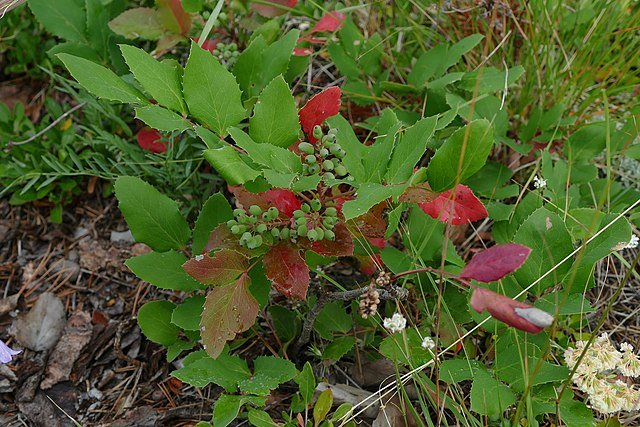Mahonia repens (or Berberis nervosa*)– Creeping Oregon Grape
Suppose you’re looking for a versatile, low-growing evergreen that can handle various garden conditions. In that case, Mahonia repens—often called Creeping Oregon Grape or Creeping Hollygrape—might be just what you need. Native to western North America, this plant stands out with its holly-like leaves, bright yellow flowers, and edible blue berries. It’s an excellent option for gardeners who want year-round beauty, support local wildlife, and minimize watering.
What Makes It Special?
Mahonia repens grows about 9 to 15 inches (23 to 38 cm) tall and can spread up to 8 feet (2.44 meters) wide, making it an excellent choice for dense ground cover. Its spiny, blue-green leaves give off a distinct holly-like vibe, and in winter, they turn a rich purplish color, adding interest when most plants are dormant. Come spring, it bursts into clusters of fragrant yellow flowers that attract bees, butterflies, and other pollinators. By late summer, blue-purple berries ripen, feeding birds.
Key Details at a Glance
Plant Type: Evergreen shrub
Growth Habit: Spreading ground cover
Height: 9–15 inches (0.75–1.25 feet)
Spread: 3–8 feet (1–2.44 meters)
Flower Color: Bright yellow
Flowering Season: April to June
Fruit: Blue-purple berries (Late summer to fall)
Hardiness: USDA Zones 5 to 9
Sunlight: Full sun to deep shade
Water Needs: Drought-tolerant once established, but occasional watering can keep it looking its best.
Where It Thrives
One of the most reassuring aspects of Mahonia repens is its adaptability. It can thrive in dry, exposed areas like uplands or fit perfectly in shady forest understories. It’s often found in regions above 3,500 feet but can handle anything from full sun to heavy shade. And don’t worry about soil quality—this plant is happy in various soil types, whether acidic, neutral, or alkaline, as long as the soil drains well.
Easy Care and Propagation
Creeping Oregon Grape spreads naturally through rhizomes and stolons, gradually covering more ground. To speed things up, you can divide and replant the rhizomes. It’s also possible to grow it from seed, though the seeds need a cold period (stratification) and have relatively low germination rates. Once the plant is settled in, it’s primarily hands-off, needing occasional pruning to remove dead branches.
Wildlife Benefits
If you’re into gardening for wildlife, Mahonia repens is a win. Its early-season flowers are a great nectar source for bees, butterflies, and even hummingbirds. Birds love the berries, which are rich in pectin, making them great for bird-friendly yards. Plus, its dense foliage provides shelter for small wildlife, so you’ll be creating a little haven in your garden.
Deer Resistance and Low Maintenance
You won’t have to worry about deer munching on Mahonia repens. Its spiny leaves naturally deter them, and the plant is almost entirely free of pests and diseases. This makes it a solid choice for gardeners looking for a low-maintenance yet beautiful, hardy ground cover.
Perfect for Your Landscape
This plant benefits gardens where you want to save water or control erosion. It’s ideal for dry, shady spots under trees or rocky slopes where other plants might struggle. Pair it with other drought-tolerant natives like Juniperus scopulorum (Rocky Mountain Juniper) or Amelanchier alnifolia (Serviceberry) for a cohesive and water-wise landscape. Whether you’re going for a naturalistic or formal garden design, Mahonia repens fits right in.
Simple Care Tips
Soil: Prefers well-drained soil but adapts to sandy or clay soils.
Water: Minimal water once established. In prolonged dry spells, water occasionally, especially if planted in full sun.
Pruning: Very little is required—remove dead or damaged branches as needed.
Fertilization: Not essential, but a light application of slow-release fertilizer in spring can encourage growth.
If you’re after a rugged, low-maintenance groundcover that offers year-round beauty, Mahonia repens should be at the top of your list. Whether you want to stabilize a slope, attract wildlife, or enjoy its evergreen foliage, seasonal flowers, and berries, this plant is a fantastic choice for gardeners looking for resilience and beauty with minimal effort.
* Recent genetic studies have led to the reclassification of many Mahonia species under the Berberis genus. While some sources still list this species as Mahonia nervosa, others, including major botanical databases, now refer to it as Berberis nervosa.
Wikipedia contributors. (2023, November 4). List of Berberis and Mahonia species. In Wikipedia. https://en.wikipedia.org/wiki/List_of_Berberis_and_Mahonia_species
Yu, C.-C., & Chung, K.-F. (2021). Mahonia vs. Berberis unloaded: Generic delimitation and infrafamilial classification of Berberidaceae based on plastid phylogenomics. Frontiers in Plant Science, 12, 720171. https://www.frontiersin.org/articles/10.3389/fpls.2021.720171/full

